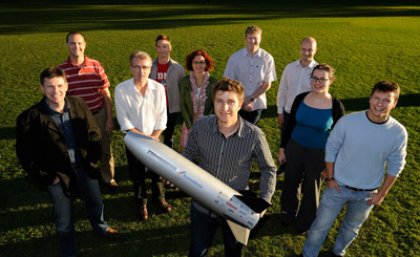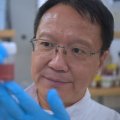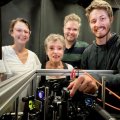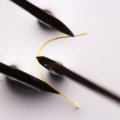
A rare public viewing will be Brisbane’s chance to see the SCRAMSPACE hypersonic scramjet before it faces its ultimate test – a space launch in Norway.
The 1.8 metre-long scramjet is a research project led by The University of Queensland. It will be available for public viewing from 11 to 11.45am on 8 July at UQ’s Advanced Engineering Building at the St Lucia campus.
A media opportunity is available beforehand, with a 10am briefing, and opportunities for photos and filming from 10.30am to 11am.
Scramjets are air-breathing engines that travel at hypersonic speeds and this one is set to reach 8600km/h in its test flight at the Andøya Rocket Range.
SCRAMSPACE Project Director and Chair for Hypersonics at UQ Professor Russell Boyce said the public viewing was a chance to share the finished scramjet with the public before it was shipped to Norway for its final voyage to space.
“We have been working with our project partners to test the components of this scramjet in the laboratory with wind tunnels and simulations for the past three years, but testing the scramjet in real flight conditions will be the ultimate test,” Professor Boyce said.
“The test period itself will last for just three seconds before the scramjet completely combusts, but the amount of data we can collect in those seconds is enormous.
“It will give us insights into hypersonic physics, hypersonic combustion, performance of materials and components and how we will make these vehicles fly in future.”
After its public viewing in Brisbane, the SCRAMSPACE scramjet will be packed up ready for shipping in August to Andøya, 300km inside the Arctic Circle.
On launch, spacecraft will reach an altitude of 340 kilometres by a two-stage rocket. After leaving the atmosphere, the scramjet vehicle will separate from the rocket, and orient itself for the re-entry with small thrusters, for what Professor Boyce describes as a “hypersonic swan dive”.
During the return flight, gravity will accelerate the vehicle to Mach 8 – about 8600km/h. This is when the team will collect the most valuable data, before the scramjet self-destructs over the sea as planned.
UQ Deputy Vice-Chancellor (Research) Professor Max Lu said the scramjet was the culmination of many years collaboration with global partners to develop solutions for the aerospace industry.
“Australia is a world leader in scramjet development and UQ is proud to play a key role in building capacity and capability in the field,” Professor Lu said.
“As part of the Australian Space Research Program, this project ultimately supports Australia’s efforts to access space.”
The public event will feature a 45-minute presentation from the SCRAMSPACE team and an opportunity to get an up-close view of the scramjet.
Event: SCRAMSPACE Showcase – See the Mach 8 hypersonic scramjet and meet the team What: A 1.8m scramjet designed to operated at eight times the speed of sound (Mach 8), and the team behind it. Date: July 8 Media presentation: 10am to 10.30am Photo/video opportunity and question time: 10.30am to 11am Public presentation: 11am to 11.45am
Who:
• SCRAMSPACE Director and Chair for Hypersonics at UQ Professor Russell Boyce
• Scramspace Project Manager and Technical Lead Dr Sandy Tirtey
• Project team members
• Project partners
• UQ Senior Deputy Vice-Chancellor Professor Deborah Terry
• Hear and Say representatives.
RSVP here.
Website: http://hypersonics.mechmining.uq.edu.au/scramspace1
Facebook page: https://www.facebook.com/ScramspaceOne?fref=ts
Twitter: https://twitter.com/ScramspaceOne
Media: Janelle Kirkland, UQ Communications, 07 3346 0561 or j.kirkland@uq.edu.au
About the SCRAMSPACE project
SCRAMSPACE is the first and largest project funded by the Australian Space Research Program. It builds on Australia's world-class hypersonics heritage, and its core objective is to build capacity and capability, in particular a talent pool, for the Australian space and aerospace industry.
This is achieved partly by means of the Mach 8 flight experiment, for which a team of exceptional young scientists and engineers has been assembled, and partly through extensive ground-based research involving many PhD students at UQ and partner universities.
Partners in the program include UQ, the University of New South Wales, the University of Adelaide, the University of Southern Queensland and the University of Minnesota.
It also includes Australia's Defence Science and Technology Organisation, which has assisted with training and access to equipment; industry partners BAE Systems, Teakle Composites and AIMTEK; aerospace agencies and research organisations from Germany (DLR), Japan (JAXA) and Italy (CIRA); and the Australian Youth Aerospace Association.
About The University of Queensland (UQ)
The University of Queensland, Australia, is one of the world’s premier teaching and research institutions. It is consistently ranked in the top 100 in the four leading independent global rankings. With more than 45,000 students and 7500 staff, UQ’s teaching is informed by research, and spans six faculties and eight research institutes.
.jpg)









